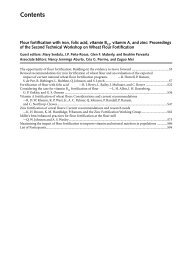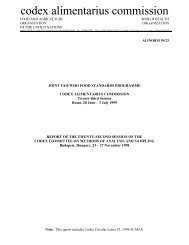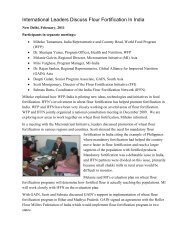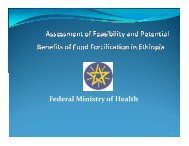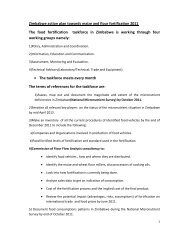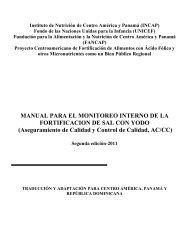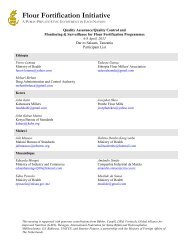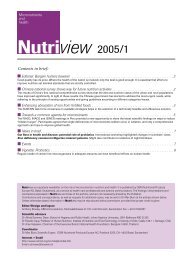concept note. - Flour Fortification Initiative
concept note. - Flour Fortification Initiative
concept note. - Flour Fortification Initiative
Create successful ePaper yourself
Turn your PDF publications into a flip-book with our unique Google optimized e-Paper software.
effective advocacy to national policymakers, the workshop aims to build the capacity of participants to develop aneconomic case for wheat flour and maize meal fortification based not only on globally accepted scientific evidencebut also on the specific national demographic, health and economic environment.Workshop Objectives:To equip national advocates with the tools to effectively make the economic case for wheat flour and maize mealfortification to national policy makersWorkshop AgendaA 5 day program will engage participants in an interactive process including expert presentations and paneldiscussions as well as a series of structured national break-out discussion groups. While plenary sessions willintroduce general <strong>concept</strong>s and principles, these break-out sessions will provide the opportunity for nationalteams to focus on the specific country context for fortification. This structured sequence of exercises will be drivenby a simple excel-based modeling tool which links national data and assumptions, agreed upon and inserted intothe excel sheets by participants, to algorithms based on global scientific literature and program experience. Themulti-sheet excel tool provides a framework which leads, step-by-step, to: estimates of the baseline national costof vitamin and mineral deficiencies; to projections of reduced economic burden possible via wheat flour and maizemeal fortification; and finally to a benefit cost projection. Prior to the workshop, participant teams will be providedwith a list of national data and statistics required to insert into the excel tool and drive the algorithms. The stepby-stepapproach is as follows:Establish the baseline economic burden – the cost of doing nothing.The scientific literature has developed coefficients of loss, evidence-based estimates of health risks andfunctional deficits associated with anemia, vitamin and folic acid deficiency. Using the excel tool,participants will apply these global coefficients to national demographic, labor and health statistics toquantify the annual economic losses associated with the current national prevalence of iron deficiencyanemia, vitamin A and folic acid deficiencies.Estimate potential coverage offered by fortified wheat and maize flour.Participants will review options for data on national wheat flour and maize meal production andconsumption available from international as well as national sources. Through group discussion, nationalteams will agree on provisional estimates for the number of maize and wheat flour consumers; theirroutine level of daily intake; and the proportion of national consumption that passes through an industrialmilling environment where it can be cost-effectively fortified.Project possible effectiveness of fortification in reducing national prevalence of deficiency.Using current or proposed national standards, or optionally, the WHO Recommendations on Wheat andMaize <strong>Flour</strong> <strong>Fortification</strong> 2009, participants will consider the added nutrition protection delivered byroutine consumption of fortified maize or wheat flours. These estimates along with a review of theliterature and program evaluations will enable participants to roughly project a scenario for theeffectiveness of fortified wheat and maize flour in preventing micronutrient deficiencies amongconsumers.Page 2



